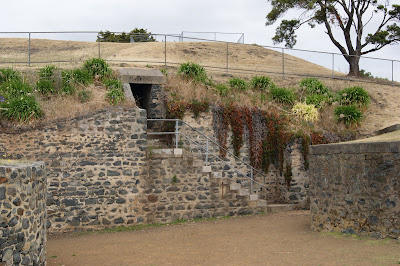The first people to inhabit the Levendale area were the Portmairremener, a band of the Oyster Bay Tribe who lived mainly around the mouth of the
This failure led Arthur in 1831 to appoint George Augustus Robinson to locate and bring in the remaining aboriginals. During October, Robinson camped at Hobbs Lagoon and passed over the head of
Due to the nearly impenetrable nature of the bush, Europeans did not settle at Levendale until the second half of the nineteenth century. Indeed, so dense was this bush that the area was originally known as "The Scrub".The first known settler was Henry Buscombe who selected 655 acres (2.65 km2) of land at Levendale in 1842, calling his property Cutting Grass Marsh. In 1845, Henry's brother James purchased a 50-acre (200,000 m2) block alongside his brother's property at the Cutting Grass Marsh. Sometime between 1852 and 1868 a William Hodgson became the third person to take up land in the area when he purchased 709 acres (2.87 km2) a Levenbanks.The assessment roll for 1858 shows John McConnon leasing 100 acres (0.40 km2) near the Prosser River and in 1861 he was leasing 1,000 acres (4.0 km2) from the Crown at Prosser River. By 1868 John and his son John William McConnon were leasing 820 acres (3.3 km2) at Levenbanks and in 1870 John is recorded as owning 80 acres (32 ha) with a hut on the land. Following the deaths of the Buscombe brothers (Henry 1844: James 1851) a William Brown leased the Buscombe's blocks in 1861. In 1873 Kele Balsley, a native of
The first task facing these early settlers was of course to carve out farms and homes from the dense bush – a thankless and difficult job. At first this work was carried out by hand, the settlers ring barking trees and cutting the undergrowth with axes and slash hook, the ash from the annual summer burnings used as fertilizer to help in the growth of grass and clover for cattle. The introduction of horses and bullocks at least provided some relief from the hard task of settlement. The settlers' first homes were built from split timber with shingle roofs. As there was no running water, one of the main daily tasks was the carrying of water from nearby creeks, a responsibility often given to the youngest members of the family. As most homes had no bathroom, bathing was done by hip bather, the water heated in tins on open fires or wood stoves. Hurricane lamps and candles provided the only source of light. Of course the settlers of necessity had to be nearly self-sufficient in such a remote settlement.
Straight-grained trees that split easily were used to provide palings and posts for buildings and fences; vegetable gardens were established, and each household produced its own milk, butter and eggs. Meat came from the farm's own livestock, and if that source of supply fell short then there was always the ever-present wallaby or rabbit to tide the family over. The preservation of food was always a problem, but salting down vegetables and the use of wet sand packs for butter in summer ensured a reliable supply of household necessities. The purchase of essential items such as flour, tea, sugar and salt meant a fairly arduous journey to either Oatlands or Sorell every three months.
Whilst most of the young men worked on the farms, either their own or a neighbor's, many traveled around the district shearing sheep or working as farm hands for the wealthier farmers. Sawmilling also was an important part of the area's history. This industry also supplied local men and boys with employment. The earliest mills belonged to the Campbell, Barker and McConnon families. These were steam engine operated and supplied timber for many of the local homes and buildings. Young women not employed at home usually found work as housemaids or a shop assistants until they married and had their own families; families that not uncommonly ran to thirteen or more children.
The continued growth of Levendale towards the end of the 1890s led to local demands for improved services to cater for the growing needs of the community. High on the list of priorities was a local school. Following strong representations from the Reverend T. W. Pitt, Church of England Minister at
In 2013,
























































